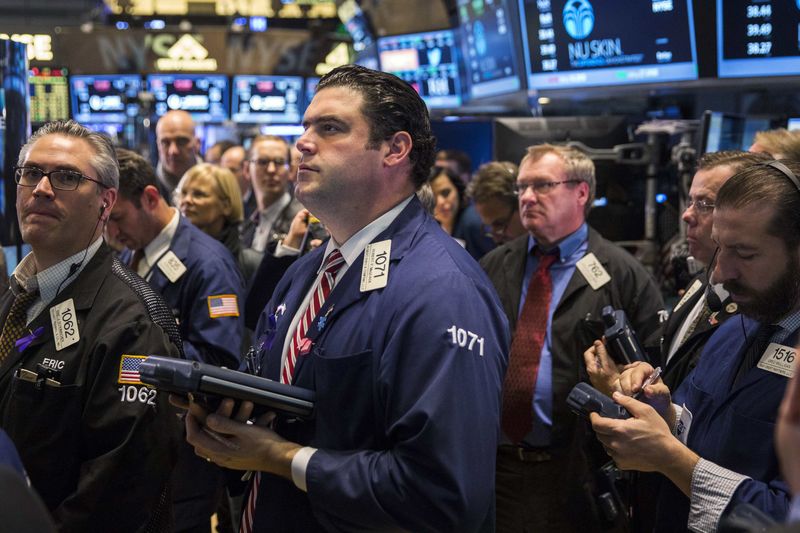Investing.com - Here are the top five things you need to know in financial markets on Thursday, February 15:
1. Global Stock Market Rally Continues
Global stock markets continued higher, extending this week's strong rally as equity investors appeared to take strong U.S. inflation data in their stride.
Asian markets closed mostly higher, with a 1.4% rise for the Nikkei 225 index and almost a 1.8% jump for the Hong Kong Hang Seng Index, though trading volumes in much of the region were capped by the coming Lunar New Year holiday.
In Europe, the continent's bourses posted solid gains, as strength seen in markets overseas boosted sentiment. Germany’s DAX index climbed about 1% in early action.
On Wall Street, U.S. stock futures pointed to a positive open, setting the Dow on course for its fifth up day in a row, as the equity market keeps rebounding from its tumble earlier this month.
Dow futures were up nearly 290 points, or 1.2%, while S&P 500 futures rose 22 points, or 0.8%. Nasdaq 100 futures added 50 points, or roughly 0.8%.
Wall Street surged on Wednesday, with the three major indexes all posting gains of more than 1%.
2. Treasury Yields Continue Higher; U.S. 10-Year Nears 2.95%
U.S. Treasury yields continued this year's rally, with the benchmark 10-year note reaching an intraday high of 2.944%, a level not seen since January 2014. It was last at 2.930%, up 1.7 basis points, or 0.6%.
The 10-year yield has not been above 3% since early 2014 and some investors believe that level will be tested in the weeks ahead. It started the year at 2.4%.
The 7-year note yield hit a high of 2.877%, its strongest level since April 2011, while the 5-year yield touched a peak of 2.687%, a level last seen in April 2010.
If yields continue to breakout, that will certainly start weighing on equities again. Rising bond yields can crimp demand for assets perceived as riskier, such as stocks, particularly when those yields are higher than those of equities.
3. Dollar Stays On The Defensive
The U.S. dollar stayed on the backfoot, hitting a new 15-month low against the yen, despite expectations of more rapid interest rate hikes by the Federal Reserve, as worries over growing fiscal deficits weighed.
The dollar index, which gauges the U.S. currency against a basket of six major rivals, was down 0.3% at 88.62, after losing more than 0.6% a day earlier despite the strong inflation number.
Against the yen, the dollar dropped as far as 106.18, its weakest level since November 2016. The U.S. currency later pared some of its losses and was last down 0.5% at 106.45.
Elsewhere, the euro edged up 0.3% to 1.2485, after earlier reaching a 10-day peak of 1.2510.
On the data front, Thursday's calendar features more top-tier U.S. data on inflation. The Commerce Department will publish producer price inflation figures for January at 8:30AM ET (1330GMT).
Surveys on manufacturing conditions in the Philadelphia and New York regions, as well as reports on weekly jobless claims and industrial production are also on the agenda.
4. Bitcoin Closes In On $10,000-Level
Bitcoin neared the $10,000-level, as the digital currency continued to recover from heavy selloffs earlier this month. Prices have been on a steady climb since comments made by U.S. regulators at a Senate hearing last week were construed as more positive than expected.
Bitcoin was last up around 8% at $9,508, its highest since February 1. The price is up over 19% for the last week after falling to a more than two month low of $6,000 on February 6.
Other major cryptocurrencies also traded higher, with Ethereum, the world’s second largest cryptocurrency by market cap, climbing around 5% to $904.
The third largest cryptocurrency Ripple gained around 6% to trade at $1.0707.
Meanwhile, Litecoin rallied for a second day, surging another 20% to $218, the strongest level since January 15.
5. Oil Prices Add To Gains After Best Day In Months
Oil prices continued higher, one day after enjoying their biggest one-day gain in more than two months, as U.S. crude stocks rose less than expected and Saudi Energy Minister Khalid al-Falih said major oil producers would prefer tighter markets than end supply cuts too early.
U.S. WTI crude futures rose 0.7% to $61.01 per barrel, adding to a 2.4% gain from the day before, its biggest one-day rise since December 26.
Brent crude futures were at $64.50 per barrel, up 0.2%, extending Wednesday's 2.6% climb.
